The Ball-of-Light Particle Model predicts a Pulsar is a ball-of-light that has a very powerful electromagnetic wave sweeping across its surface. The pulsar has no outer envelope of material such as the outer plasma envelope of a normal star.
The Ball-of-Light Particle Model predicts Pulsars are caused by a collision. A massive object such as a star or a planet hits a star with so much energy that the core of the colliding object penetrates the star's outer plasma envelope and physically collides with the star's inner core. This causes a massive electromagnetic wave to start sweeping over the core of the star. The massive wave sweeps all of the outer enveloping plasma off the core of the star. In the section explaining planetary nebulae, I created an animated gif image that shows a relatively small object impacting a star -- causing the planetary nebula.
With a pulsar the impacting object's size is larger. (The following animated gif exagerates the size of the impacting object.)
Thus, all that is left is: a compact and ultradense stellar core; a core that has an intense nonthermal spectrum; a core with a massive electromagnetic wave sweeping over it; a wave intense enough as to induce smaller particles that are ejected off the poles creating particles that may further decay.
I believe supernova are caused by objects colliding with a star and affecting the core of the star. The core can completely explode, creating one type of supernova, or can partially explode, leaving behind a pulsar. (The impact that starts a pulsar, causes an explosive decay mode and decay products that surround pulsars. The Crab Pulsar is an example of where a supernova has a pulsar in its center.)
A recent animation from the Hubble Space Telescope shows balls-of-light being ejected from the poles of the Crab Pulsar.
The electromagnetic field that sweeps over a pulsar -- from pole to pole -- should have certain predictable characteristics. First of all, as noted elsewhere on this web site, the Ball-of-Light Particle Model predicts how electromagnetic fields will orient themselves on the surface of a sphere. The simplest case is show in the following graphic:
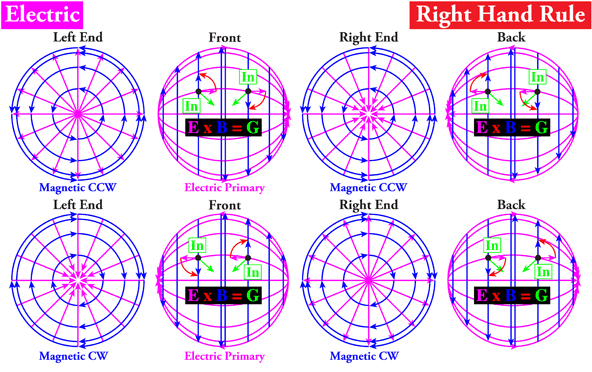
In the top row, look at the second sphere from the left. In this sphere, an electric field -- in blue -- is sweeping from left to right. Notice the orientation of the magnetic field -- represented by magenta. On the left hemisphere, the magnetic field curls according to the left hand rule. On the right hemisphere, the magnetic field curls according to the right hand rule. The magnetic field changes direction of curl at the equator.
The traditional view of a pulsar is that it is a spinning neutron star. Note, as shown in the following graphic, a star that is spinning has both the top and the bottom hemispheres spinning in the same direction.
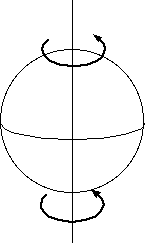
(It is interesting to note that many astromers have a big problem with the spinning star theory because many pulsars would have to be spinning so fast that they should physically fly apart -- but they do not.) I wish to be very careful to point out that the Ball-of-Light Particle Model predicts the main pulse from a pulsar is caused by a sweeping electromagnetic field -- a field that sweeps from pole to pole over the star -- not from a spinning star. These poles are determined by the collision that created the supernova and the pulsar. However, before the collision, the star already had a spin. The main poles for the star prior to the collision -- statistically -- would almost never match up with the main poles of the star after the collison. Thus there would be left over angular momentum that would cause the pulsar to spin or precess around an axis different from the main axis the as defined by the sweeping electromagnetic field. An example is shown in the following graphic.
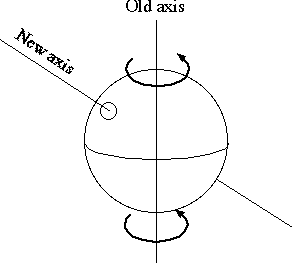
If the collision hits the star just slightly off from its original pole, then the stars main pulse will precess around the original axis as shown in the next graphic.
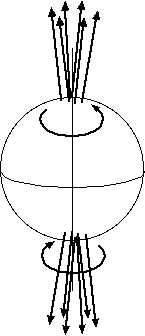
If the Ball-of-Light Particle Model is correct, then the magnetic field orientation of the top and bottom hemispheres in the above graphic should be curling in opposite directions. If the traditional theory of pulsars is correct, then the magnetic fields in the above graphic should be oriented in the same direction. A recent image of the Egg Nebula from the Hubble Space Telescope is shown below.
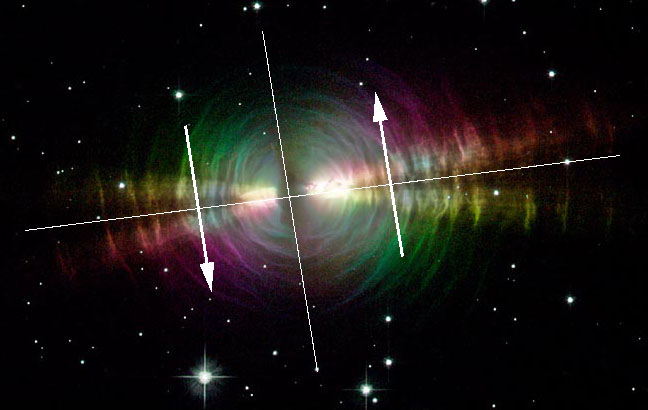
Notice how the light is polarized in opposite directions. This matches the Ball-of-Light Particle Model, not traditional theory.
See also, Thermal vs. Nonthermal Radiation, Nonthermal Radiation from Pulsars)
The Ball-of-Light Particle Model easily explains pulsars in a new manner:
under construction